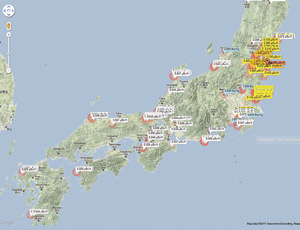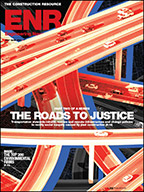Conferences are driven by themes, and the most telling themes are expressed by succinct quotes. Presenters at ENR's FutureTech conference, held in New York City in early April, offered plenty of both as they outlined key takeaways about construction and tech.

A quotation from science-fiction writer and visionary William Gibson—“The future is already here; it's just not evenly distributed”—was referenced more than once.
That quotation went a long way toward explaining how technology is now being used in engineering and design and how it is changing the construction process.
“The future” has been here for a while. Before his keynote address, Duncan Wilson, Arup Associates, London, put up a slide from a newsletter published by the consulting engineering firm in 1971. Under the headline “Central Heating Pipe Sizing by Computer,” engineer Ron Gillham wrote, “Much has been written exhorting service engineers to use the computer and praising the results obtained by those already using it. It seemed reasonable therefore that the possibility of writing a program from first principles should be examined, bearing in mind that the computer, in some form or other, will eventually replace our slide rules at the drawing board.”
That passage helped set the stage for a discussion by key players in the construction industry of how the future is beginning to arrive at a faster pace as design and construction users connect the once- scattered lights of technology, such as collaboration tools, 3D model printing, parametric modeling, real-time data visualization and project data management in the cloud.
“Information technology is beginning to have a profound effect on the way the built environment is planned, designed, procured, constructed and operated,” observed Wilson. He tied that to the rise of “GeoWeb 3.0” and what he calls an increasing trend toward self-surveillance with social networking tools.
“Checking-in” sites such as Foursquare and Living Social are examples of how end-user data creates new ways to perceive the world around us, he says.
An extreme example is the “Geiger counter” page hosted on the developer-community site Pachube that is monitoring the aftereffects of the earthquake and tsunami that struck Japan in March (see image). The crowd-sourced site contains hundreds of radiation-related feeds from citizens using applications that upload readings from their Geiger counters into the site.
The point is that it's not just making data public; it's the public making data, says Wilson. “Think of ‘data' as material and social [networks] as a process,” he suggested.
This concept, already well accepted in the social networking world, is beginning to influence the design and building world with new notions of self-reporting sensor data networked to deliver live performance feedback from infrastructure. Wilson referred to it as “the Internet of things.”
Presenting on analysis and simulation, Carl Galioto, senior principal at St. Louis-based HOK, noted that performance-based design best succeeds if it can be informed by performance data, and the earlier and more complete it is, the better.
Shawn Pressley, vice president of construction management firm Hill International, Marlton, N.J., also noted how the convergence of BIM and cloud computing will change the way we work. The typical organization chart will not work for BIM/cloud because more collaboration is required, Pressley says.
“Technology is no longer a part of the business. Technology is the business,” Pressley advised.






Post a comment to this article
Report Abusive Comment